

With other methods, types of elements do not change as simulation proceeds.ĬEL allows clear visualization of fluid free surface. SPH allows for conversion of continuum elements into small particles. However CEL can perform mesh refinement on its own as the analysis proceeds. SPH method does not require mesh refinement near small objects with geometry details.ĬEL and CFD do require minimum of several elements to model boundary layer accurately. Application example: projectile impact on fuel tank. The other two methods do not.ĬEL and SPH allow contact interface topology change due to penetration. SPH supports fluids, isotropic solids as well as anisotropic solids.ĬFD is the only technique that can model fluid turbulenceĬFD is the only technique to model porous mediaĬFD and CEL allows material flow through the mesh: EulerianĬEL method allows non-conforming meshes at the interface.

SPH method is most versatile in terms of material support. to understand their applications and limitations: We can compare these three methods against multiple parameters such as materials, contact, computation speed, etc. Application example: bird strike on an aero structure. This method can be used for fluids as well as for solids. This method uses a Lagrangain approach in which material moves with the nodes or particles and can be accessed through the Abaqus/explicit solver. SPH method: This is a smooth particle hydrodynamics approach primarily used to model unbounded fluids that undergo severe deformation or disintegrate into individual particles.Application example: Fluid motion in washing machine. This method is accessible through Abaqus/explicit solver. It’s also possible to simulate interaction between multiple materials, either fluids or solids. CEL method: This is a coupled Eulerian Lagrangian method primarily used in problems involving unbounded fluids where fluids free surface visualization is required.Application example: Flow through exhaust systems. It’s based on Eulerian formulation, in which material flows through the mesh and can be accessed through the Abaqus/CFD solver. CFD method: This is the well-known and traditional method for fluids modeling.This blog post discusses the multi physics methods of modeling fluids in Abaqus. There are many other possibilities and the right approach depends on the physics of the problem.

Many of our Abaqus customers don’t know that the Computational Fluid Dynamics approach (CFD) is not the only method of modeling fluids in Abaqus.


 0 kommentar(er)
0 kommentar(er)
